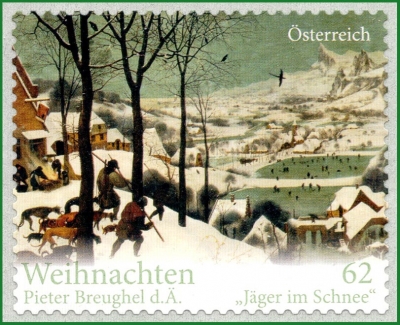-
Christmas. 2nd issue
Austria 2012.11.30
In issue: Stamp(s): 2
Printing: multicoloral offset on self-adhesive paper
Issued in: rolls
-
Number by catalogue: Michel: 3042 Yvert: 2871 Scott: 2412 Gibbons: 3195
Perforation type: 12x12
Subject:
65 euro cents.
Reproduction of the painting "Hunters in the Snow"** by Pieter Bruegel the Elder*.
In the presented fragment, you can see a water mill.Additional:
*Pieter Bruegel (also Brueghel or Breughel) the Elder; c. 1525–1530 – 9 September 1569) was the most significant artist of Dutch and Flemish Renaissance painting, a painter and printmaker, known for his landscapes and peasant scenes (so-called genre painting); he was a pioneer in making both types of subject the focus in large paintings.
He was a formative influence on Dutch Golden Age painting and later painting in general in his innovative choices of subject matter, as one of the first generation of artists to grow up when religious subjects had ceased to be the natural subject matter of painting. He also painted no portraits, the other mainstay of Netherlandish art. After his training and travels to Italy, he returned in 1555 to settle in Antwerp, where he worked mainly as a prolific designer of prints for the leading publisher of the day. Only towards the end of the decade did he switch to make painting his main medium, and all his famous paintings come from the following period of little more than a decade before his early death, when he was probably in his early forties, and at the height of his powers.
As well as looking forwards, his art reinvigorates medieval subjects such as marginal drolleries of ordinary life in illuminated manuscripts, and the calendar scenes of agricultural labours set in landscape backgrounds, and puts these on a much larger scale than before, and in the expensive medium of oil painting. He does the same with the fantastic and anarchic world developed in Renaissance prints and book illustrations.
He is sometimes referred to as "Peasant Bruegel", to distinguish him from the many later painters in his family, including his son Pieter Brueghel the Younger (1564–1638).
**The Hunters in the Snow (Dutch: Jagers in de Sneeuw), also known as The Return of the Hunters, is a 1565 oil-on-wood painting by Pieter Bruegel the Elder. The Northern Renaissance work is one of a series of works, five of which still survive, that depict different times of the year. The painting is in the collection of the Kunsthistorisches Museum in Vienna, Austria. This scene is set in the depths of winter during December/January.
The painting shows a wintry scene in which three hunters are returning from an expedition accompanied by their dogs. By appearances the outing was not successful; the hunters appear to trudge wearily, and the dogs appear downtrodden and miserable. One man carries the "meager corpse of a fox" illustrating the paucity of the hunt. In front of the hunters in the snow are the footprints of a rabbit or hare - which has escaped or been missed by the hunters. The overall visual impression is one of a calm, cold, overcast day; the colors are muted whites and grays, the trees are bare of leaves, and wood smoke hangs in the air. Several adults and a child prepare food at an inn with an outside fire. Of interest are the jagged mountain peaks which do not exist in Belgium or Holland.
The landscape itself is a flat-bottomed valley (a river meanders through it) with jagged peaks visible on the far side. A watermill is seen with its wheel frozen stiff. In the distance, figures ice skate, play hockey with modern style sticks and curl on a frozen lake; they are rendered as silhouettes.
__________
Information is taken on Wikipedia. Follow the link to see the panting in detail.
Topics: Mills in Art Watermills



2012-1s-frgm.jpg)